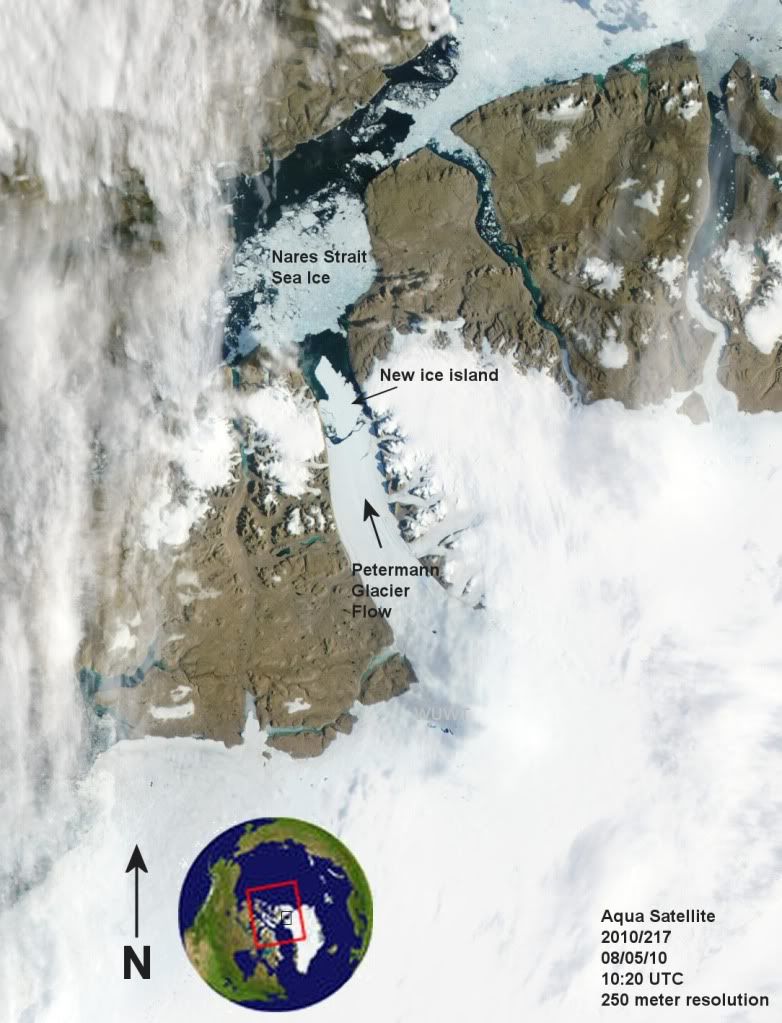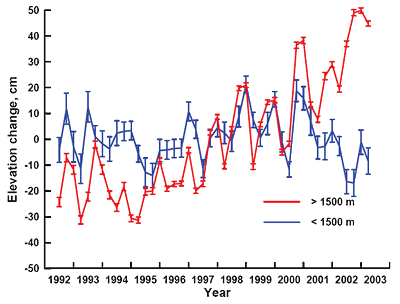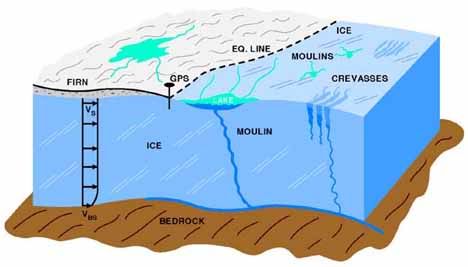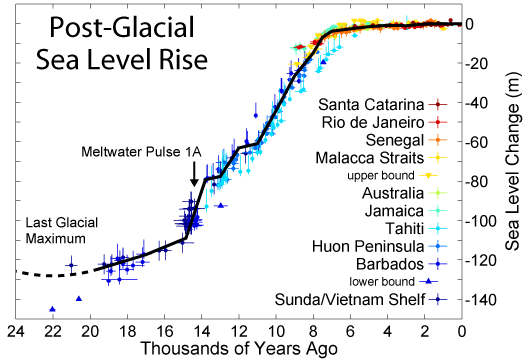A 20km-wide iceberg broke off a Greenland ice shelf recently. It has been used by the media as a
powerful emblem in their coverage of global warming. But there's a huge irony here. Because, if anything, a larger iceberg is indicative of more snowfall and greater ice mass rather than warming temperature -- more snow and ice making for a faster flow and huger ice blocks. Warmer temperatures would cause the opposite to this, with the ice receding, and hence less ice for breaking off into big chunks.
(photo via
Watts Up With That.)
The iceberg broke off in an inlet of water of the Arctic Sea in the north of Greenland. It is a piece of
ice shelf; a tongue of ice that floats over seawater supplied by the mass of land ice behind it. It is more melted and dissipated by sea water than by air temperature. From
wiki:
"...Rough mass balance estimates using these scales suggest that about 80% of its mass is lost as basal meltwater..."
Therefore, if it is breaking off huge chunks it's more likely to mean that the ice is moving faster and not having time to melt into the sea. Please don't be alarmed, though, by the fact that it is
"moving faster". This sort of change is more likely to be caused by more snow accumulation, not
"melting" as interpreted by the alarmist media.
The ice shelf normally creeps forward at around
1km per year. But, this varies and it has been going
faster for a number of years.
Government-sponsored
science prefers to focus on the slight increase in melting at the edges of Greenland during the warming of the late 20th century:
There are wild claims of ice loss in Greenland. But these focus on the extra melting caused by warmth and ignore the extra snow accumulation on top. As I show below there's more snowfall during warmer periods.
The Greenland ice sheet was
gaining mass according to satellite altimetry up to the year 2003:
There is
newer satellite data from
NASA from 2003 that contradict the older results up to 2003. Given NASA's tweaking of the
ERBE satellite results and GISS's upward
tweaking of land temps I wouldn't trust them on these latest Greenland ice loss claims.
As I said above: a bigger iceberg should imply more snowfall, not global warming. Having said that though, break-offs can be influenced by any number of local conditions such as ocean currents and ocean temperature and wind.
Temperatures are actually cooling the last few years on Greenland (
1,
2,
3) and this will slow the ice melt.
Prior to these last 3 years of cooling, during the warmer period of the 1990's and early 2000's, the Greenland ice sheet was affected by warming temperatures, causing it to lose mass at the edges and gain it in the middle.
This is to be expected for a slight warming: more melting (ablation) around the edges and more precipitation on top in the form of snow.
When it comes to glacier flow it's important to recognize that ice is a thermal insulator. The bottom layer and all layers on top except for the very top-most layer are immune to air temperatures.
The two main things that can make a glacier flow faster are increased ice mass and geothermal heat. A minor influence can come from plate tectonics like earthquakes and volcanoes. It is also possible that with enough liquid precipitation or melting, streams of water can have an influence.
But, Greenland is so cold there isn't much meltwater or rain except in summer and even then not enough to endanger it. And, in any case Greenland isn't as vulnerable to liquid water streams as, say, equatorial glaciers for reasons explained presently.
There are two
types of glacier, warm and cold. Warm glaciers occur in the tropics and temperate regions. Mountain glaciers in New Zealand are a good example of a warm glacier. Warm glaciers move faster and are possibly more affected by liquid rain and meltwater. This is because the core temperatures in warm glaciers are closer to 0C -- the freezing point of water. The warmer ice has lower viscosity and the warmer air temperatures can sublimate the ice quicker, so they are more vulnerable to climate change.
By contrast, in cold glaciers like Greenland and Antarctica the ice moves more slowly, has less heat for lubrication, and is less susceptible to the spreading of liquid streams.
(Picture from
Daily Mail)
The property of being a warm or cold glacier occurs as it is being formed. If it is formed under cold conditions, for example, it will still be a cold glacier even if the air temperature outside was to suddenly increase. This due to the insulating effect of ice.
A glacier is not going to melt from the bottom up even if there is a bit of liquid (in the form of water) conveying heat to parts of it underneath its surface.
AGW scientists
claim that the water from the moulins can spread across the bottom of the ice sheet and lubricate its movement.
I'm no glaciologist but I don't see how this sheeting of water at the bottom can occur. Surely if the water was somehow able to sheet across the bottom it would refreeze under the intense cold and pressure.
Glaciers move forward through
viscous flow not by lubrication from water. (Video
here.)
The intense pressure causes the normally solid ice to act viscously like a fluid. Heat can lubricate this flow by making the solid ice less viscous. Liquid is not required to lubricate glaciers to make them move. In any case the liquid water wouldn't lubricate due to the intense pressure from the ice. Water does not act like a lubricant under these conditions. (Just on that point, an ice skater doesn't glide over the ice by melting the ice under the blade of the skate but rather, because the solid ice transforms viscously under pressure and allows such movement.)
The glacier is just as frozen on the bottom as it is in the middle (aside from a slight warming due to geothermal heat -- see graph below). And Greenland sits in a basin making the bottom of the ice sheet below sea-level. Even if you could lubricate the bottom through heat from the atmosphere or water it would still not flow uphill!
So, the scientists' claims of global warming causing a
surging in the glacier flow are not true. It's mainly extra ice mass from snowfall and other factors that cause the surging.
Coming back to the insulating property of ice, it is such a good insulator that it retains traces of the physical temperature from thousands of years ago. It takes hundreds or thousands of years for atmospheric temperature changes to be reflected deep down. A sudden increase will not melt them!
This NASA
webpage shows how the physical temperature influence of the air at the time of deposition is retained in the ice for thousands of years in Greenland. It's not going to melt anytime soon even if air temps go up!
Greenland and Antarctica are secure in their position inside the polar circles. The large land ice sheets of the last ice age in Canada and Eurasia outside the Arctic Circle melted away thousands of years ago.
The Holocene period has been
mostly warmer than today for 12,000 years. If Greenland and Antarctica were going to melt they would have done so by now. The Medieval Warm Period would have melted them. The Roman Thermal Optimum would have melted them. But they didn't.
A Penn State colleague of Michael Mann, Richard Alley, recently
testified to the US Congress that a 2 - 7C temp increase could melt Greenland's ice in a matter of decades flooding the world. This is an unbelievable distortion.
Following is a graph which shows why we need not fear warming melting the polar ice caps. For warmth has the effect of increasing the precipitation on the ice sheets:
(From webpage
here. By the way, this graph is from the same Richard Alley mentioned above that testified to Congress that a 2 - 7C temp increase would melt Greenland! Of all people he should know better -- that warmth
increases the snow and hence the ice sheet!!)
Greenland and Antarctica basically operate at ice load saturation. They have as much ice as they will hold with the excess creeping forward and breaking off into the sea, such as we see presently with this Greenland ice calve.
With Greenland and Antarctica safely tucked within their polar circles warmth can only increase the ice mass (due to precipitation), not decrease it as the above graph shows. With average temperatures in the Arctic and Antarctic well below freezing, a 2C temperature increase is not going to melt all that ice anyway. Greenland creates its own zone of cool temperature that carries through even in the summer months:
Antarctica's ice sheets are secure even if there were to be a few degrees temperature rise in air.
Glaciers are the product of an ever-changing equilibrium between ice loss at the edge and ice gain on top from snow.
As long as the snowfall continues to rise when it gets warm as it has in the past Greenland will not melt and Al Gore won't have to sell his recently acquired California beachfront property!
























































